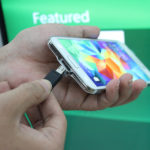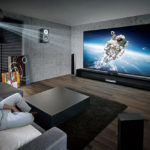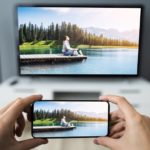Projector is a device commonly used for presentation and lectures in classrooms or meetings. To display images and videos from a computer on a projector, you need to connect the two devices together. Below are 6 most commonly used methods of connection, you can refer to.
Top 6 ways to connect a computer to a projector
1. Connect computer to projector via VGA cable
- Step 1: First, turn on the projector by pressing the POWER button on the remote control or on the projector body. Wait for the light to turn green to ensure that the projector is operating. If you have just turned off the projector, wait for a while for the fan to stop completely before turning it on again.
- Step 2: Next, you plug the VGA cable from the projector into the laptop, be careful to ensure that the VGA port and the plug of the projector are securely connected to each other.
- Step 3: Press the power button on the computer then wait a few minutes for the devices to complete the connection process. Note that when using VGA connection, avoid touching the cable too much as it will change the color and reduce the image quality.
/fptshop.com.vn/uploads/images/tin-tuc/174065/Originals/6-cach-ket-noi-may-tinh-voi-may-chieu-1.jpg)
2. Connect computer to projector via USB-C cable
USB-C port is also a popular method of connecting a computer to a projector, especially on Apple’s MacBook models. To connect a computer to a projector via the USB-C port, you can follow these steps:
- Step 1: Turn on the projector by pressing the POWER button on the remote control or on the projector body and wait until the light turns green. If the projector is turned off, wait for a period of time for the fan to stop spinning before turning it on again.
- Step 2: Use a USB-C cable to plug one end into the connection port on your computer and the other end into the projector.
- Step 3: Start your computer and wait a few minutes for the two devices to connect to each other.
/fptshop.com.vn/uploads/images/tin-tuc/174065/Originals/6-cach-ket-noi-may-tinh-voi-may-chieu-2.jpg)
With the USB-C port, the process of connecting a computer to a projector becomes simple and effective, providing high-quality image experience.
3. Connect computer to projector via HDMI cable
HDMI is one of the most common connection ports for both laptops and desktop computers. To connect a computer to a projector via HDMI port, you can follow these steps:
- Step 1: Use an HDMI cable and plug one end into the HDMI port on your laptop.
- Step 2: Plug the other end of the HDMI cable into the HDMI port on the projector.
- Step 3: Turn on the projector and start your computer.
/fptshop.com.vn/uploads/images/tin-tuc/174065/Originals/6-cach-ket-noi-may-tinh-voi-may-chieu-3.jpg)





































